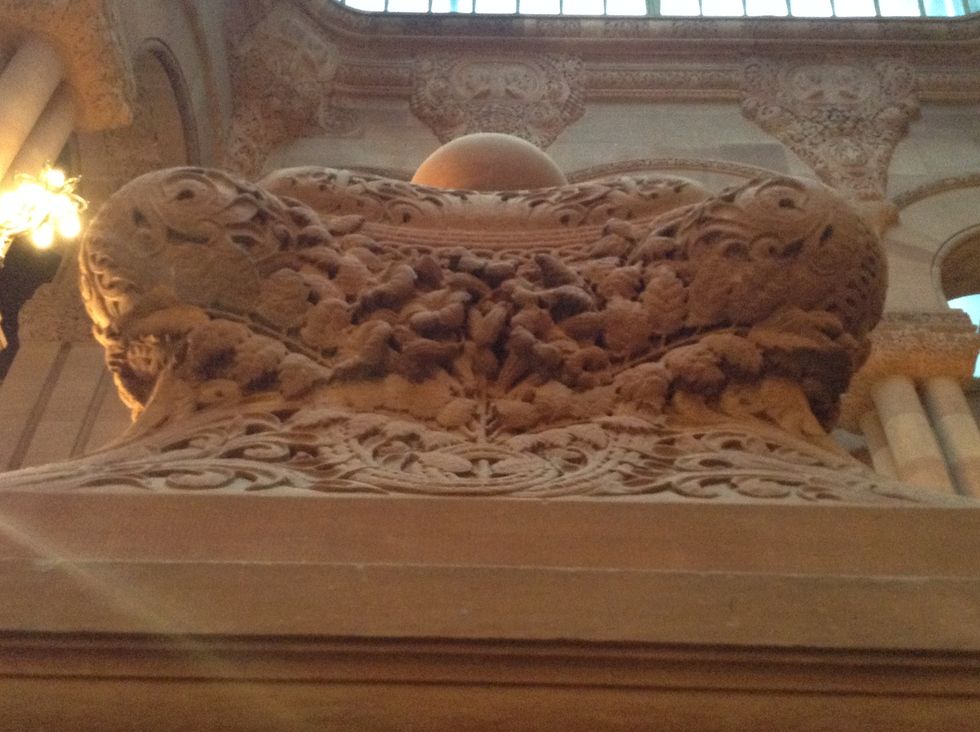Located in downtown Albany lies the New York State Capitol Building. In the heart of the building is The Great Western Staircase, also known as “The Million Dollar Staircase”. The project began in 1883 and took fourteen years to complete; it contains 444 steps and rises 119 feet in height. Henry Hobson Richardson was the original design, but Isaac G. Perry oversaw its construction while Louis Hinton worked with over 500 stone carvers to ensure that the detail was phenomenal. From observing the staircase on its many winding levels it is clear to see that the staircase is monumental, and was built with pride and dedication to craftsmanship. After having been restored by the New York State Office of General Services from 2000 to 2002, the staircase is renewed and open for the public’s eye.
My first impression when visiting the staircase was that it seemed in no way meant to function as a stairway to get from one place to another. The staircase is built with too much detail and style, that it seems more of a walkthrough sculpture exhibit rather than transport. The staircase is made of granite, corsehill freestone, limestone, and medina sandstone that gives it the burnt orange-red tint. I walked through all four floors of the staircase and noted the basic architecture, studying it from the general to the detail. The staircase is characterized by wide center walkways, high ceiling levels, short stone railings, archways, and columns. It is indeed a baroque styled staircase and it gallantly reflects that. Combining this with all the detail that decorates these walkways, railings, and archways, made it seem as if the staircase was speaking to me and observing me as much as I did it. I found the staircase very inviting, and I thought that if it could speak it would brag and say “Look at me! Look at the level of craftsmanship I was built with.
The angular and mazey structure of the staircase will lead one in any direction. While there are different details, portraits and set of carvings on each floor, there is a level of continuity and uniformity that it seemed to latch onto. It reminded me of the well-known lithograph print “Relativity”(1953), by M.C. Escher, in which people are allowed to move throughout in every direction including upside down and against gravity. Yet the staircase was not so animated and operated by alternating between very angular structures and curved archways. The detail that decorates the angular railings and rounded archways are prominent from any vantage point in the vicinity. The contrasting and alternations between the railings and the archways in the staircase’s design is reminiscent of church buildings, particularly cathedrals and old churches with high ceilings. The dusty ashy color generally adds to the attitude of longevity that the staircase actively portrays. It makes it seems it was designed to look old from its first construction.
What’s notable about the decorative detail in the architecture is the various repetitions of themes such as liberty, flora, fire, and the sea. There are numerous little-hidden gems that reflect these concepts. For liberty, I found carvings that are associated with justice and national pride such as shields with ribbons around them, crossed swords, and balancing scales. I can only imagine these to directly correlate to the purpose the building serves.
There were a lot of references to flora, that includes references to fire and flames, that lined the railings and any structure that didn’t function as a stair or a column. This includes blossoming roses, grapes, vines etc. The heads of the railings, knobs, and even the lamps are littered with carvings of leaves.
One particular detail that I noted about the characteristics of the leaves was that the ends of them were very spiky and harsh, and while it may been made this way to add to the realisticness of the carvings, it appeared very fiery in certain instances. On some of the heads of the railings were depictions of flowers emerging from their roots and leaves, where the leaves seemed to shoot out underneath them like fire.
There were also many references to water, particularly the ocean. There were carvings depicting ships on waves, sails, and swirling designs. One of the details I noted in the architecture that referenced the sea is in the lamps. Certain lamps that stood erect on a pole had heads that swirled like seashells, and some lamps that appeared to float near the edges of railings appeared similar to jellyfish with golden tentacles.
What was most notable about the staircase, however, were the carvings of famous figures such as George Washington, Abraham Lincoln, Ulysses S. Grant, Susan B. Anthony and so on and so forth. The carved portrait heads are immensely detailed. It is a clear that the carvers studied profiles of those carved because the portrait heads have an extreme likeness to their subjects. It is almost flawless in that the skin appears smooth like butter, every wrinkle or fine line on a subjects face is noted, and the eyes crafted with the sense of giving the onlooker the feeling that they are directly conversing with the heads. Most of them are positioned so that when an individual passes the heads, they will be able to look directly into the face. The lesser detailed heads are the flat profiles that are carved into the corners near the laylight of the highest point on the staircase. Theses flat portraits are most concerned with achieving a likeness in general head shape and essence, rather an extremely detailed exhibit like the portrait heads that line the walls.
Overall, my experience at The Great Western Staircase gave me a new appreciation for architecture and fine detail as I am sure it does for the general public that visits it. It is clear that the construction of the staircase took so long to build because of the nature of the materials and the amount of time it takes carvings a satisfactory design into stone. At the time, finding the resources to build such an extravagant staircase were mostly difficult but not as strenuous as it would be for today’s world. What was 1.5 million back then could equate to quadruple times the cost now, most likely more. Architects, construction workers, and stone carvers were far more serious and loyal to their craftsmanship back in those days.




















